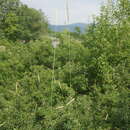ar
الأسماء في صفحات التنقل


Taktak (Hordeum bulbosum Torn.), xarduma, togʻarpa — boshoqdoshlar oilasiga mansub koʻp yillik oʻtsimon oʻsimlik, begona oʻt. Boʻyi 50—190 sm. Boshogʻi 6—13 sm, eni 6—7 mm, qalami, moʻrt. Ostki gul qipigʻining qiltigi 4— 6 sm, T.ning yer osti qismi kichikroq piyozga oʻxshash tuganak hosil qiladi. May—iyun oylarida gullab, meva tugadi. Adir va togʻ yonbagʻirlarida, vohalardagi gʻalla ekinlari orasida va marzalarda, yoʻl yoqalarida oʻsadi. Pichanbop oʻsimlik hisoblanadi. Baʼzan doni oziq-ovqat uchun ishlatiladi. Poyasi tez dagʻallashgani va serqiltiqligi tufayli boshoqlagunga qadar oʻrib olinadi. Oʻzbekistonning barcha viloyatlarida tarqalgan.
Hordeum bulbosum, bulbous barley, is a species of barley native to southern Europe, northern Africa, the Middle East and as far east as Afghanistan, with a few naturalized populations in North America, South America and Australia. Since 1970 it has been used in the Hordeum bulbosum Method (or Technique) to produce doubled haploid (DH) wheat and barley plants by crossing it with T. aestivum or H. vulgare, followed by the elimination of the H. bulbosum chromosomes from the offspring.[2] These DH plants are important in breeding new varieties of wheat and barley, and in scientific studies. H. bulbosum is also being looked at as a source of genes for disease resistance and other traits for barley crop improvement.[3]
Hordeum bulbosum, bulbous barley, is a species of barley native to southern Europe, northern Africa, the Middle East and as far east as Afghanistan, with a few naturalized populations in North America, South America and Australia. Since 1970 it has been used in the Hordeum bulbosum Method (or Technique) to produce doubled haploid (DH) wheat and barley plants by crossing it with T. aestivum or H. vulgare, followed by the elimination of the H. bulbosum chromosomes from the offspring. These DH plants are important in breeding new varieties of wheat and barley, and in scientific studies. H. bulbosum is also being looked at as a source of genes for disease resistance and other traits for barley crop improvement.
Hordeum bulbosum est une espèce de plantes monocotylédones de la famille des Poaceae, sous-famille des Pooideae, originaire d'Eurasie et d'Afrique du Nord. Cette espèce, susceptible de s'hybrider, bien qu'avec difficulté, avec Hordeum vulgare, constitue le pool génique secondaire de l'orge commune. Hordeum bulbosum est une source intéressante de gènes de résistance à divers agents pathogènes, notamment fongiques et viraux, pour l'amélioration des cultivars d'orge cultivée[2].
Ce sont des plantes herbacées vivaces, cespiteuses, aux tiges de 50 à 100 cm de long, renflées en bulbes à la base, et à l'inflorescence composée de racèmes[3].
Selon Tropicos (11 mai 2017)[4] (Attention liste brute contenant possiblement des synonymes) :
Hordeum bulbosum est une espèce de plantes monocotylédones de la famille des Poaceae, sous-famille des Pooideae, originaire d'Eurasie et d'Afrique du Nord. Cette espèce, susceptible de s'hybrider, bien qu'avec difficulté, avec Hordeum vulgare, constitue le pool génique secondaire de l'orge commune. Hordeum bulbosum est une source intéressante de gènes de résistance à divers agents pathogènes, notamment fongiques et viraux, pour l'amélioration des cultivars d'orge cultivée.
Ce sont des plantes herbacées vivaces, cespiteuses, aux tiges de 50 à 100 cm de long, renflées en bulbes à la base, et à l'inflorescence composée de racèmes.
Hordeum bulbosum (binomen a Carolo Linnaeo anno 1756 statutum) est species generis Hordei et familiae Poacearum. In Asia meridio-occidentali alicubi colitur recentiusque in agricultura Civitatum Foederatarum temptatur.
Hordeum bulbosum (binomen a Carolo Linnaeo anno 1756 statutum) est species generis Hordei et familiae Poacearum. In Asia meridio-occidentali alicubi colitur recentiusque in agricultura Civitatum Foederatarum temptatur.
Hordeum bulbosum é uma espécie de planta com flor pertencente à família Poaceae.
A autoridade científica da espécie é L., tendo sido publicada em Centuria II. Plantarum...8, 115. 1756.[1]
Trata-se de uma espécie presente no território português, nomeadamente em Portugal Continental.
Em termos de naturalidade é introduzida na região atrás indicada.
Não se encontra protegida por legislação portuguesa ou da Comunidade Europeia.
Hordeum bulbosum é uma espécie de planta com flor pertencente à família Poaceae.
A autoridade científica da espécie é L., tendo sido publicada em Centuria II. Plantarum...8, 115. 1756.
Hordeum bulbosum là một loài thực vật có hoa trong họ Hòa thảo. Loài này được L. mô tả khoa học đầu tiên năm 1756.[1]
Hordeum bulbosum là một loài thực vật có hoa trong họ Hòa thảo. Loài này được L. mô tả khoa học đầu tiên năm 1756.
Ячмень луковичный (лат. Hordeum bulbosum) — вид травянистых растений рода Ячмень (Hordeum) семейства Злаки (Poaceae).
Многолетнее травянистое растение высотой 50 - 100 см. Стебель голый, гладкий, при основании луковицеобразно утолщенный. Листья 3 - 7 мм шириной, плоские, линейные, слегка шероховатые, сверху иногда волосистые[2][3].
Колоски линейные, 6 - 13 см длиной и 6 - 9 мм шириной. Колосковые чешуи среднего колоска узколанцетной формы. Нижняя цветковая чешуя среднего колоска голая, эллиптически ланцетная, 8 - 11 мм длиной, с тонкой остью; цветковые чешуи боковых колосков без остей. Цветёт в мае - июне. Анемофил[2][3].
По информации базы данных The Plant List, в синонимику вида входят следующие названия[4]:
Обитает на степных склонах, каменистых осыпях и склонах[2].
В России обитает на Восточном Кавказе и в Южном Крыму. Вне России встречается в Средней и Малой Азии, в Иране и в Средиземноморье[3].
Ячмень луковичный (лат. Hordeum bulbosum) — вид травянистых растений рода Ячмень (Hordeum) семейства Злаки (Poaceae).
球茎大麦(学名:Hordeum bulbosum)为禾本科大麦属下的一个种。
|access-date=中的日期值 (帮助)